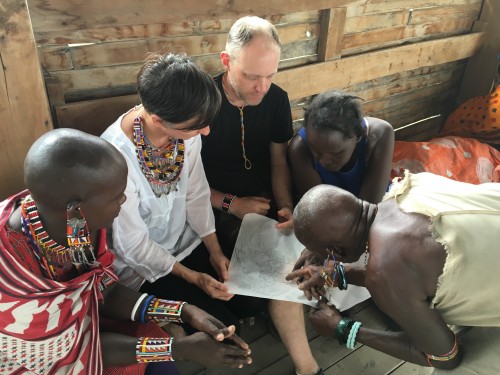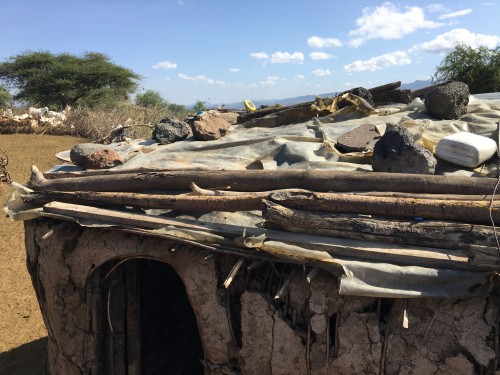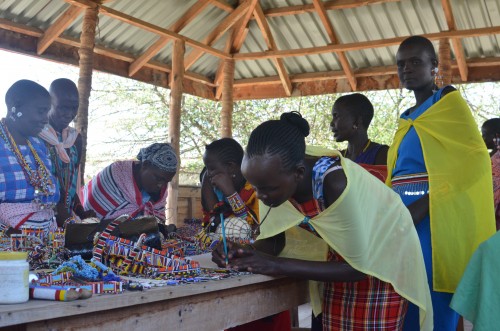
Our final workshop day included a group discussion following LAGI presentation of a Boma Solar design.These sketches represented the third iteration of the solar structure design, which took into consideration the architecture of the manyatta, the traditional Maasai jewelry, and the sketches that OMWA made on the first day. Photo by Tereneh Mosley
In the winter of 2015, LAGI was contacted by Tereneh Mosley, the founder of Idia’Dega, who has been working since 2013 with Maasai Women Artisans in Olorgesailie—a remote location in South Rift Valley of Kenya where Maasai are starting to feel the pressures on land use from the outside world. One of those pressures is renewable energy infrastructure for the national grid. With excellent insolation, the land around Oloresailie is already being tapped for solar energy projects, but none of the new energy infrastructure is being planned to serve the modest needs of the local community. Rather it is being installed to serve the national grid for use in cities like Nairobi.
The work of Idia’Dega in sustainable fashion has shown that it is possible to design new products collaboratively with the Olorgesailie Maasai Women Artisans (OMWA) and other indigenous groups through processes that elevate local communities and empower them to create their own economic future on the global stage. Through her conversations with OMWA, Tereneh learned that modest electrification is something that is a pressing need—contributing to security, education, communication and creative /revenue building projects. Nearly everyone goes without light after sunset and the only way to charge cellphones is to walk an hour or more in each direction and pay someone in the nearest grid-tied village.
Building on the strong relationships and design model that Tereneh has established, Idia’Dega and LAGI have therefore embarked on a collaboration with OMWA to design culturally and aesthetically relevant solar infrastructure for off-grid Maasai homesteads. On return from our first round of design workshops we are excited to report that the ideas that resulted far exceeded our expectations. Along the translation from fashion to energy infrastructure, the group quickly realized that incorporating modest photovoltaic areas into belts, bags, bracelets, and fabrics that Maasai women and men wear during the daylight hours would be a great way to provide access to electricity at all times. In addition, small-scale solar shade structures and “banda” ornaments will provide immediate access for use within the homestead.
Over the next six months we will be fundraising and working on the detailed design drawings for fabrication, with a goal of returning in December 2016 to implement and install the multifaceted project with OMWA. Stay tuned to Idia’Dega and LAGI to see the design results. While it is most important that we provide Olorgesalie with the first products of their design efforts and meet their immediate need for electricity, we will soon thereafter be offering the designs for sale to the general public. We’re certain that everyone will want to own Maasai solar wearables and residential-scale products, and the proceeds from sales will go back to the people of Olorgesailie, helping to pay for student fees and for everyday needs for food, clothing, healthcare, and shelter that often go unmet today. Access to electricity will also help OMWA nurture their creative practice and offer the ability to connect and collaborate with other artisans around the world.
Please contact us if you are interested in supporting this project.
lagi@landartgenerator.org
You can learn more about this project here:
http://landartgenerator.org/lagi-kenya.html

The tiny solar light on the roof of this manyatta represents the amount of light that some of the homes currently have access to. It throws a little less than a flashlight. The manyatta’s are nearly pitch dark during the day.

Maasai women of Olorgesailie Kenya take the lead in designing renewable energy installations for their homesteads.
